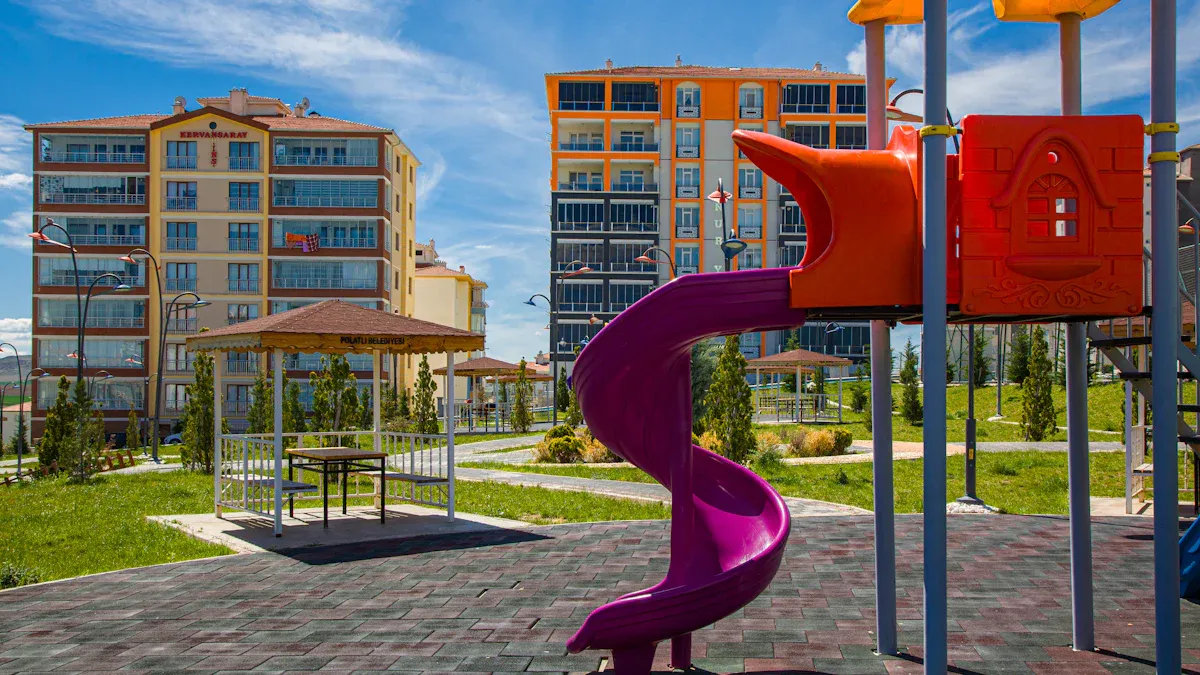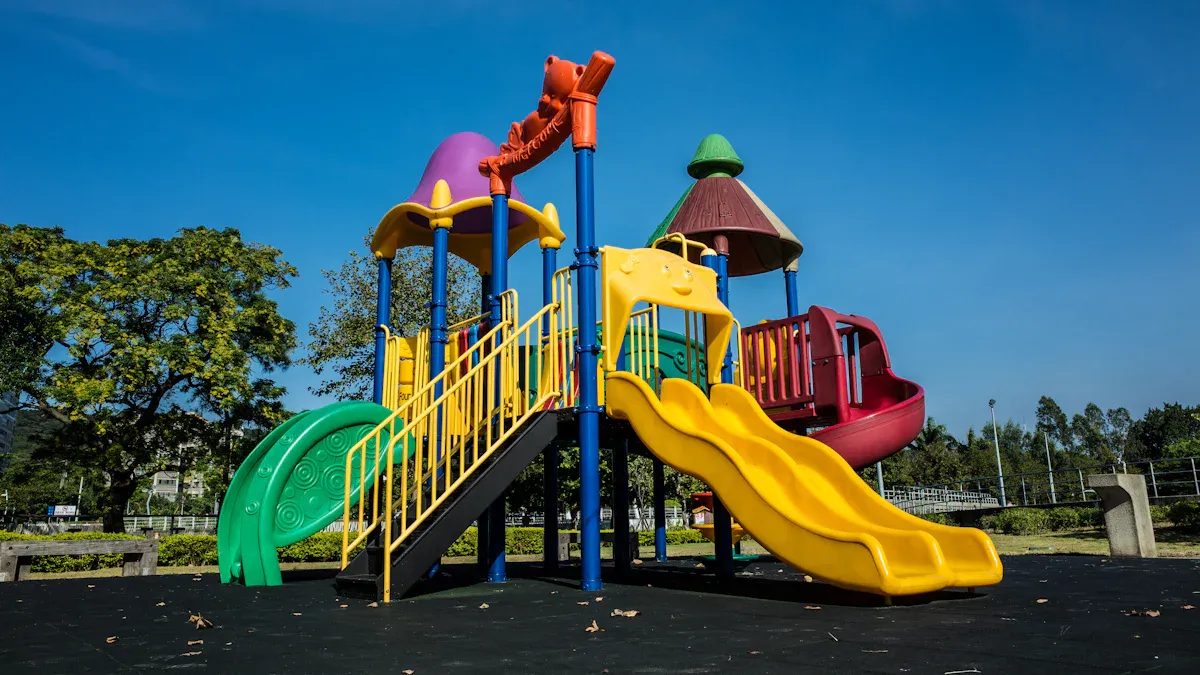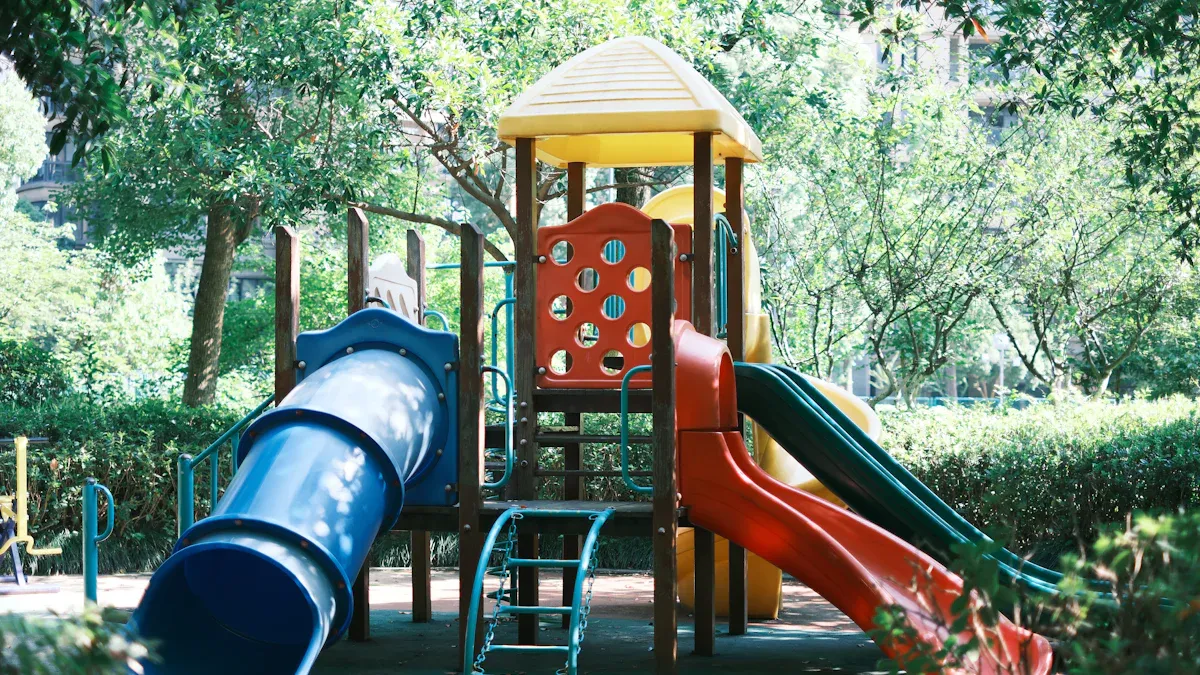
Playgrounds are evolving to meet the diverse needs of students. Spring 2025 highlights five standout categories of playground equipment: swings, climbing structures, inclusive play equipment, outdoor fitness stations, and sensory play panels. These options cater to physical activity, inclusivity, and engagement, making them essential considerations during school procurement for modern playgrounds.
Key Takeaways
- Buy strong playground gear to help kids stay active and healthy.
- Pick equipment everyone can use so all kids feel included.
- Focus on safety rules to avoid injuries and keep fun lasting.
Top Playground Equipment for Spring 2025

Swings
Swings remain a timeless favorite in school playgrounds. Their simple design offers endless fun while promoting physical activity. Swinging helps children develop balance, coordination, and core strength. Schools often choose durable materials like galvanized steel and weather-resistant seats to ensure longevity. Modern swing sets also include inclusive options, such as bucket seats and adaptive swings, allowing children of all abilities to participate. This inclusivity fosters a sense of belonging and encourages social interaction among students.
Climbing Structures
Climbing structures are essential for promoting physical fitness and problem-solving skills. These structures challenge children to navigate obstacles, improving their strength, flexibility, and spatial awareness. However, safety remains a critical consideration. According to national statistics, over 66% of school injuries occur on playgrounds, with 45% requiring emergency room assistance. Schools mitigate risks by selecting climbing equipment that meets strict safety standards and includes features like padded surfaces and secure handholds.
| Statistic Description | Value |
|---|---|
| Estimated injuries related to playground equipment | 509,650 |
| Cost to society for playground-related injuries | $9.8 billion |
| Yearly fatality estimates from playground-related injuries | 17 to 22 deaths |
Inclusive Play Equipment
Inclusive play equipment transforms playgrounds into spaces where every child feels welcome. These designs promote cooperation and camaraderie through group play components. They also provide opportunities for quieter exploration, fostering meaningful engagement among children and adults of varying abilities. By encouraging social development, inclusive equipment helps children build essential life skills. Schools increasingly prioritize these options to create equitable and enriching play environments.
- Promotes imaginary play, supporting whole-child learning.
- Encourages group play, fostering teamwork and camaraderie.
- Provides calm spaces for quieter play and exploration.
Outdoor Fitness Stations
Outdoor fitness stations combine exercise with fun, making them a popular choice for schools. These stations include equipment like pull-up bars, balance beams, and step platforms, designed to engage students of all fitness levels. They encourage physical activity during recess, helping children build strength and endurance. Schools often install these stations to promote healthy habits and combat sedentary lifestyles. Their durable construction ensures they withstand heavy use and various weather conditions.
Sensory Play Panels
Sensory play panels are gaining popularity due to their educational and therapeutic benefits. These panels engage multiple senses, enhancing language development, coordination, and problem-solving skills. The growing awareness of sensory processing disorders has led to increased integration of sensory toys into school curricula. For example, a school in Manitoba implemented a sensory path, helping students manage energy and improve focus. Sensory panels also foster creativity, making them a valuable addition to any playground.
- Enhance cognitive abilities and body awareness.
- Create new neural pathways through multi-sensory engagement.
- Support students in managing energy and improving focus.
Why These Items Are Popular
Trends in School Playgrounds
The playground equipment market has experienced significant growth due to evolving societal needs and preferences. Several trends highlight this shift:
- Increased awareness of children’s health has driven demand for outdoor play spaces.
- Urbanization has led to a rise in playground installations in densely populated areas.
- Enrollment in pre-primary programs in the U.S. grew by 18% from 2000 to 2019, boosting demand for age-appropriate equipment.
- Children spending over seven hours daily on screens has prompted schools to invest in engaging outdoor play options.
These trends reflect a growing emphasis on creating spaces that promote physical activity and social interaction.
Focus on Inclusivity and Accessibility
Modern playgrounds prioritize inclusivity, ensuring children of all abilities can participate. Accessible equipment, such as wheelchair ramps and sensory panels, fosters a sense of belonging. Schools increasingly adopt these designs to promote social interaction and equity. For instance, approximately 3.1% of U.S. children face conditions limiting their play. Inclusive playgrounds address this need, creating environments where every child feels valued.
| Trend | Description |
|---|---|
| Inclusivity | Accessible equipment promotes belonging and interaction among children with diverse abilities. |
| Safety | Innovations like impact-absorbing surfaces reduce playground injuries by 30%. |
Emphasis on Physical and Cognitive Development
Playground equipment supports both physical and cognitive growth. Climbing structures enhance strength and problem-solving skills, while sensory panels stimulate creativity and language development. Outdoor fitness stations encourage healthy habits, addressing concerns like childhood obesity. These features align with schools’ goals to nurture well-rounded development in students.
Durability and Safety Standards
Schools prioritize equipment that meets rigorous safety and durability standards. Testing methods, such as structural integrity and impact attenuation, ensure equipment withstands heavy use and minimizes injury risks. Material safety testing guarantees non-toxic, weather-resistant components, making playgrounds safe and long-lasting.
| Type of Testing | Purpose |
|---|---|
| Structural Integrity Testing | Ensures equipment can support children’s weight and activity. |
| Impact Attenuation Testing | Verifies surfaces cushion falls to reduce injury risks. |
| Material Safety Testing | Confirms materials are non-toxic and durable under various conditions. |
Benefits of Investing in Quality Playground Equipment

Enhancing Physical Activity and Health
Quality playground equipment plays a vital role in promoting physical activity among students. Major playground upgrades often lead to increased activity levels and reduced sedentary behavior. Children enjoy exploring new equipment, which boosts their self-efficacy and well-being. These positive experiences encourage healthier habits and improve overall fitness. Schools that prioritize such investments create environments where students can thrive physically and emotionally.
- Playground reconstruction increases physical activity levels.
- Upgraded equipment reduces sedentary behavior.
- Enjoyment of new playgrounds enhances well-being and social interactions.
Encouraging Social Interaction and Teamwork
Playgrounds provide opportunities for students to develop essential social skills. Equipment designed for group activities fosters teamwork and communication. Children learn to share, take turns, and collaborate effectively. These interactions help them build meaningful friendships and manage emotions. Research shows that 90% of adults believe playgrounds are crucial for teaching cooperation and sharing. Schools can enhance these benefits by selecting layouts that encourage collaborative play.
| Evidence | Description |
|---|---|
| 90% of adults | Believe playgrounds teach children cooperation and sharing. |
Supporting Cognitive and Creative Development
Playground equipment supports cognitive growth by encouraging problem-solving and imaginative play. Sensory panels and climbing structures stimulate creativity and critical thinking. These activities help children develop language skills and spatial awareness. Schools that invest in diverse equipment options foster whole-child development, preparing students for academic and social success.
Ensuring Long-Term Safety and Durability
Durable playground equipment ensures safety and reduces long-term costs. High-quality materials like galvanized steel and UV-resistant plastics withstand heavy use and harsh weather. Compliance with ASTM and CPSC standards minimizes safety risks. Comprehensive warranties, such as 10-15 years for metal frames, reflect product reliability. Regular maintenance further extends the lifespan of playground installations, making them a wise investment for school procurement.
- Equipment complies with IPEMA, ASTM, and ADA standards.
- Materials include rust-resistant metals and durable plastics.
- Warranties and maintenance practices ensure longevity.
School Procurement Tips for Choosing the Right Equipment
Assessing Student Needs and Preferences
Understanding student needs is essential when selecting playground equipment. Schools can gather insights through surveys and interviews with students and parents. For example, a study in Victoria, Australia, revealed that children value outdoor play and social interactions but express concerns about bullying and equipment conflicts. This feedback helps schools identify features that promote inclusivity and engagement. Additionally, public participation in playground design ensures the equipment aligns with children’s preferences, fostering long-term usage and satisfaction.
Prioritizing Safety and Compliance
Safety should be a top priority in school procurement for playgrounds. Schools must evaluate equipment for compliance with safety standards like ASTM and CPSC. A systematic approach, including preliminary hazard analysis, helps identify and mitigate risks. Features such as impact-absorbing surfaces and non-toxic materials enhance safety. Regular inspections and adherence to guidelines ensure playgrounds remain secure and functional, reducing the likelihood of injuries.
Tip: Partnering with certified suppliers ensures compliance with safety regulations and provides peace of mind for schools and parents.
Considering Budget and Maintenance Costs
Budget constraints often influence school procurement decisions. Conducting a market analysis helps schools understand pricing trends and identify cost-effective options. Financial reports highlight the importance of proactive maintenance, which prevents costly repairs and extends equipment lifespan. Routine inspections can address minor issues early, safeguarding financial resources. Schools should also consider cooperative purchasing agencies to access affordable, high-quality equipment.
Partnering with Reputable Suppliers
Choosing reliable suppliers is crucial for ensuring quality and durability. Suppliers with strong performance reviews often deliver better products and services. Evaluating factors like quality, capacity, and pricing helps schools select providers that meet their needs. Effective supplier partnerships enhance operational efficiency, reduce costs, and ensure timely delivery. Schools benefit from working with experienced suppliers who prioritize safety and innovation in playground equipment.
Spring 2025 showcases a diverse range of playground equipment, including swings, climbing structures, inclusive play options, outdoor fitness stations, and sensory panels. These items combine fun with developmental benefits, making them essential for modern school playgrounds.
Investing in high-quality, inclusive, and durable equipment ensures safety, fosters engagement, and supports student growth. Schools should prioritize these features to create enriching play environments that stand the test of time.
FAQ
What are the key safety standards for playground equipment?
Playground equipment must comply with ASTM, CPSC, and ADA standards. These ensure structural integrity, impact absorption, and accessibility for children of all abilities.
Tip: Always verify certifications when selecting equipment.
How can schools maintain playground equipment effectively?
Schools should schedule regular inspections, clean surfaces, and address minor repairs promptly. Proactive maintenance extends equipment lifespan and ensures safety for students.
- Checklist for Maintenance:
- Inspect for wear and tear.
- Tighten loose bolts.
- Replace damaged parts.
Why is inclusive playground equipment important?
Inclusive equipment ensures all children, regardless of ability, can participate. It fosters social interaction, equity, and a sense of belonging, creating a welcoming environment for everyone.
Emoji Insight:
Post time: Apr-07-2025
